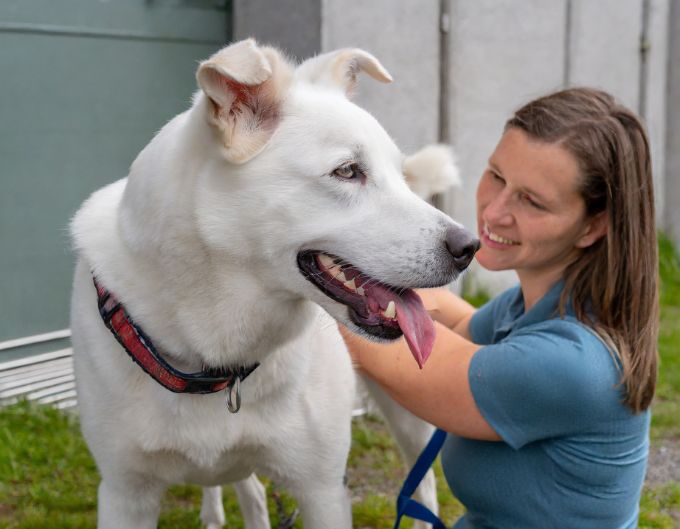We all love chocolate, but we also know that our lovely pups can’t eat it. But the question is, “what is the effect of chocolate on dogs?”. That is what we will answer in this article, we will go through all the information you need to know about the effects of chocolate on a dog.

The Symptoms of Chocolate Poisoning
The main signs of chocolate poisoning in dogs are vomiting, diarrhea, restlessness, and the more severe symptoms are seizures and heart issues.
Let’s say that an accident happened, and your dog somehow eat a bit of chocolate, what are the symptoms that they are poisoned or a sign that they need help quick?
Early and Advanced Symptoms in Dogs
Very common signs of chocolate poisoning are restlessness, vomiting, and diarrhea, progressing to more severe symptoms such as seizures and heart issues. Early detection and response are vital in preventing critical outcomes.
If you see any of these symptoms in a dog after they have eaten chocolate, you need to rush to the vet. Sadly enough, you can’t really do anything at home to help your dog survive. Rushing to the vet is the best thing to do.
It takes a dog around 72 hours on average to show symptoms, so your dog can be ok for like a day, even if they are a small breed. This is why this is very important to treat your dog early.
This depends though because there are also studies that says that it could take from 6 to 12 hours for symptoms to show up.
Why Chocolate is Toxic to Dogs
You probably already know that chocolate contains something that is poisonous to your pup. But what is it?

The Toxic Ingredients: Theobromine and Caffeine
Chocolate contains theobromine and caffeine, known as methylxanthines, which are extremely harmful to dogs. While humans can easily metabolize these compounds, dogs process them much more slowly, leading to a buildup of toxins in their system.
Just for an understanding of how deadly chocolate is for a dog, one once of milk chocolate per pound of body weight is enough to kill your dog. This is chocolate milk, and not chocolate itself.
If you want to read more about chocolate and what it contains and stuff, I recommend you checking out this article.
Understanding the Severity of Chocolate Poisoning
The level of toxicity depends on the type of chocolate and the dog’s size. For instance, dark chocolate contains higher levels of theobromine and caffeine, posing a greater risk. Even small amounts can be dangerous, especially for smaller breeds.
A larger breed dog (adult) has a much higher chance to survive the toxins in chocolate than smaller breeds. Good to keep in mind. But you shouldn’t wait “extra” on getting to the vet because your dog is larger. Chocolate is still deadly, just to note that.
The BIG QUESTION is: Can dogs eat white chocolate?
The questions that many dog owners probably has asked themselves, “is white chocolate deadly to dogs?”. And I have the answer, and it is that it is rarely deadly for dogs, as milk or dark chocolate is.
The reason white chocolate is not as deadly is that it only has 0.25 mg of theobromine per ounce of chocolate. Which is a very little amount of theobromine and isn’t that deadly for a dog.
And no, you can’t still feed dogs white chocolate. I know that it is not deadly because it doesn’t have a large amount of theobromine per ounce of chocolate. But according to the ASPCA, if your dog eats candy that’s high in sugar, it can cause vomiting and diarrhea.
Immediate Response and Treatment
In this very unfortunately situation, what should you even do to save your dog’s life?
What to Do if Your Dog Eats Chocolate
If you suspect your dog has ingested chocolate, immediate action is necessary. Assess the situation and consult a veterinarian as soon as possible, this can be done with a phone call. So that you can get some information on what to do.
You could also contact a Pet Poison Helpline who can help you through the situation.
Veterinary Treatments for Chocolate Toxicity
Veterinarians may use treatments like activated charcoal and IV fluids to manage the toxicity. The treatment approach will depend on the severity of the symptoms and the amount of chocolate ingested.
Case Study: Hudson the Labrador’s Chocolate Poisoning
There is a case study that shows the symptoms of chocolate poisoning.

Hudson, a 15-month-old Labrador, suffered from chocolate poisoning after consuming an Easter egg. He displayed symptoms like ataxia and vomiting. Rapid veterinary intervention, including detoxification and monitoring, led to a full recovery.
This is an interesting case study in my opinion, if you want to read the full case study take a look at this article.
Preventing Chocolate Poisoning in Dogs
If this would ever happen to you, that your dog somehow eats chocolate, it could be good to know what you can do to preventing chocolate poisoning in a dog.
Keeping Chocolate Away from Dogs & educate your kids
The easiest tip is to store chocolate in inaccessible places and educate your household about the dangers of chocolate to dogs, if they didn’t know for some reason. Prevention is always better than cure.
There isn’t really that much you can do, then put the chocolate away from your dog. Now, if you have a small kid who always wants their candy every weekend, sometimes they might have their hands on chocolate. And I can guess that there are chances that they might not know what is dangerous for a dog.
You don’t have to take the chocolate away from the kid, but telling them the danger of chocolate for dogs could prevent any accidents.
That were the effect of chocolate on dogs
In conclusion, the danger chocolate poses to our beloved dogs cannot be overstated. As responsible pet owners, it’s our duty to ensure the safety and well-being of our furry family members.

By understanding the harmful effects of chocolate, recognizing the signs of toxicity, and knowing how to respond in case of an emergency, we can prevent tragic incidents. Let’s commit to keeping chocolate out of reach and educating others about this hazard.
Together, we can create a safer environment for our dogs, where they can thrive and live happily without the risks posed by everyday human treats like chocolate.
More Helpful articles!
If this articles was helpful to you, then these might be for you:

